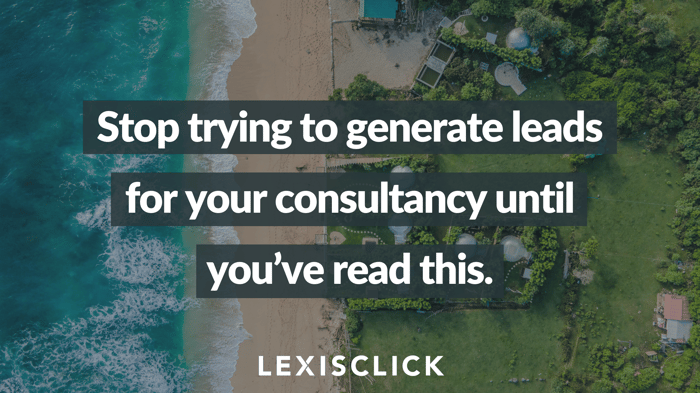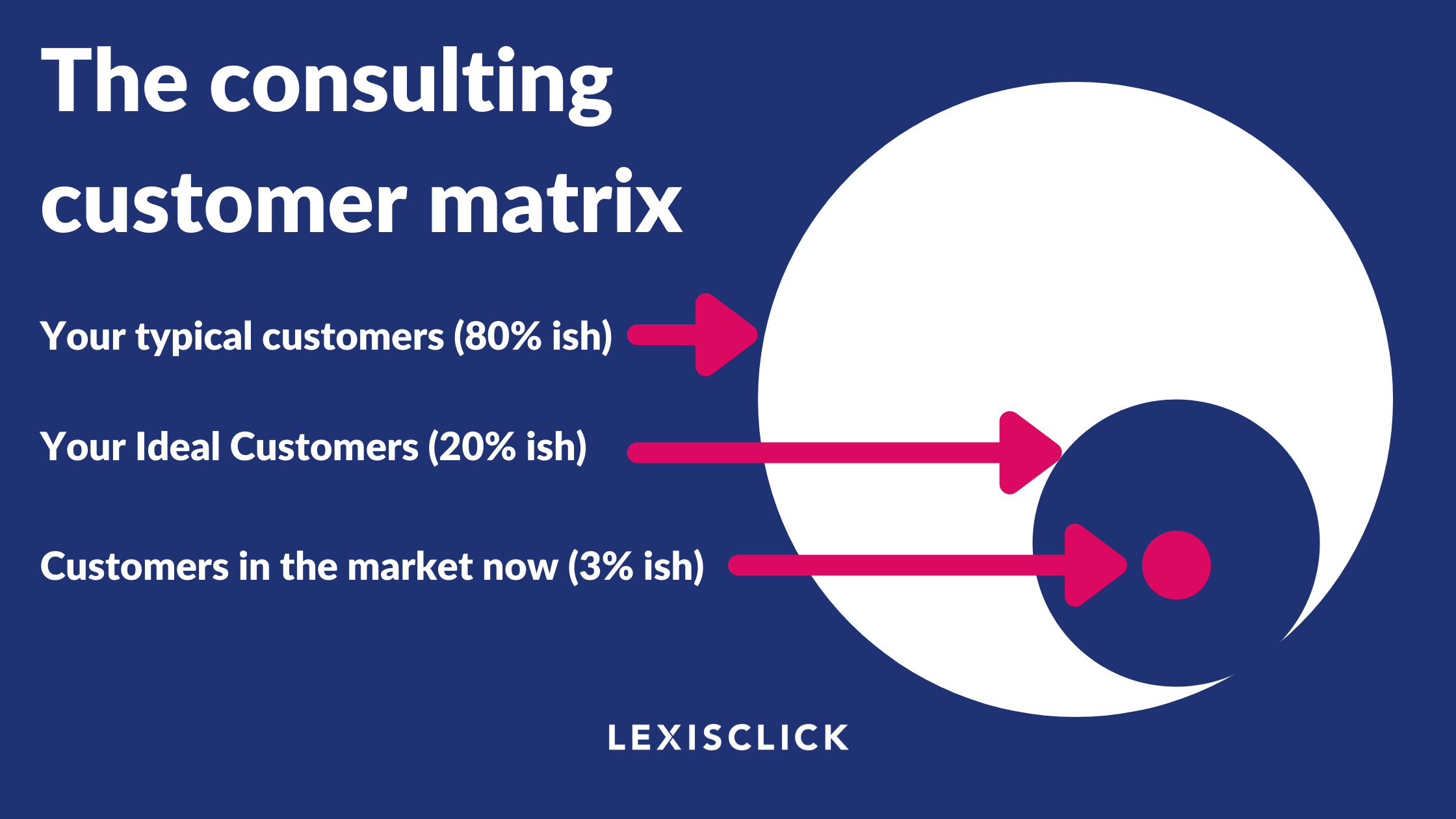
Are most of the leads you’re generating a waste of time? Is your CRM full of contacts that are going nowhere? Are you and your sales team going mad that your marketing isn’t generating the quality leads to hit your sales targets every month? If these questions have got you thinking, get stuck into this post to learn how to solve these problems.
Here's an overview of what we'll be covering in this post:
- From going nowhere to going somewhere
- Quality over quantity
- Attracting your ideal leads
- We need more traffic to get more leads
- We don’t have a marketing automation system
- We’ve tried a niche campaign before, and it failed
- Have you defined the lead qualification criteria for your consultancy?
- Quality leads make everything easier

From going nowhere to going somewhere
Most consultancy marketing just generates views and contacts that go nowhere.
These make you think you’re doing the right things, but they’re really worth nothing and cost you a fortune in wasted time.
Are you investing time and money into marketing that doesn’t generate any tangible results? If you are, you need to make it your priority to fix it. All this time and money should be generating a tangible return on investment that will give you the confidence to invest even more.
Are the leads that you are generating low quality and wasting your sales team’s time? If you’re finding they are, it means that they are being handed over to your sales team too early. It’s another area that should be a top priority for your marketing team to work on so that you or your sales team are getting the leads they need.
Is your CRM full of contacts that are going nowhere? This is another sign that your marketing isn’t working hard enough or capturing the right leads for you. You want your CRM to be a greenhouse that is nurturing the right leads so that your sales team always have plenty to harvest and hit their sales targets each month.
Quality over quantity
When you’re working to grow and scale your consultancy, you know you need more sales. To get more sales, you need more leads, right?
No one will blame you for thinking that - it’s the obvious answer. The thing is that all leads are not created equal. To scale, you’ve got to be efficient with your time. You don’t need more leads; you need the right leads.

I’m sure you’re familiar with the Pareto Principle, aka the 80:20 rule. When applied to business, the rule is that 80% of your profit will come from 20% of your customers.
You must identify that 20% of your customers, as they are probably your ideal customers. You want to attract those customers, as each one of them is worth five times more than an average customer.
As we're already talking percentages, it's also worth noting here that only around 3% of your customers will be in the market for your service at any one time.
When you attract the right leads, they want to speak with you, they have the problems you fix, and they buy more easily. If they’re your ideal customers, they are also worth five times more than all the others.
Just imagine if all the leads you generate were your ideal customers, if your CRM database was full of ideal customers, and you or your sales team were selling to ideal customers every day. Life would be much easier, wouldn’t it?
Scaling your consultancy would be a dream, rather than the hard slog it probably is now.
So, how do you go about realising this dream?
Attracting your ideal leads
First things first, you need to be clear on who your ideal customer is.
Some consultancies struggle with this as they have a few. Here are my tips on how you can deal with this.
1) Defining your ideal customers
- Start with a campaign to target the ideal customer you have identified. You’re not looking to pivot your whole consultancy; you just want to start attracting the right leads.
- Identify a target audience that you can deliver a consistent outcome to and you are passionate about serving.
- Apply the 80:20 rule and identify which of these customers will be your ideal customers.
- Now list out the problems they have that you solve for them. Think of all the problems you can. You want as long a list as you can come up with that will give you plenty of inspiration to communicate with them.
- Now identify where these ideal customers go to solve the problems you solve for them.
Get this information into a document and describe all the relevant points in terms of your ideal prospects. Where can you get in front of them, and what messages do you think they’ll respond to?
You may be sitting on the fence and thinking that you want to target more than one ideal customer.
If you find yourself in this position, whatever you do, don’t try to target both customer groups with one campaign.
Create a campaign for each group and prioritise which campaign you want to start with. You’re going to have lots to learn to start attracting the right leads. The last thing you want to do is to try and chase two different ideal customers simultaneously. Otherwise, you’ll end up like the man who tried to chase two rabbits and caught none.
The time to go after the second group of ideal customers either when you’re attracting all of the first group that you can, or that you’ve decided that this group isn’t right and it’s time to move on.
2) Define your lead qualification criteria
One of the biggest time wasters for salespeople is unqualified leads. If leads are unqualified, it means that they need to spend their time qualifying them, only to find out they aren’t ready to buy and need to be passed back to marketing.
If you’re the founder of your consultancy and are also responsible for sales, this problem is even more costly because you don’t have the time to waste. The chances are you’re responsible for sales, some of the delivery, as well as running the business, meaning that every second counts.
Marketing can work at scale, whereas sales always demands time on a one to one basis.
To get marketing doing the qualification work at scale, you have to have well-defined lead qualification criteria, and these criteria have to be identifiable automatically. You’ll also need a marketing automation system like Hubspot to make the process easier. Without a system to manage it, the task will be monumentally tricky.
Here's an overview of the general marketing to sales leads stages:
-width-2240-name-Consulting lead stages (1).png)
And here’s how to set your qualification criteria:
- Define the criteria of a quality contact. What are the essential factors that all of your ideal customers share? Ideas include their role, company size, problem, industry sector, the technology they use etc.
- Define the criteria for a sales-ready lead. Here are some standard criteria:
- They have a problem you can fix
- They want to solve the problem in an appropriate timeframe
- They have a suitable budget to solve it
- The person can make or influence the decision
- They want to speak with you
When you have defined your ideal customer profile for the campaign you are running, you can define the criteria that a lead needs to meet to be qualified. Make sure you are very clear on how closely your leads need to match your ideal customer profile to be qualified. You must decide on the essential factors that your leads meet and which are nice to have.
For a lead to be qualified and sales-ready, they must want to speak with you. If a lead doesn’t want to speak with you, they’re just a contact. Sure, contacts can be converted to leads, but that is going to take time. If you have a business development rep whose job is to reach out to contacts and convert them to leads, that’s fine. But if you’re responsible for sales as the founder, you’ll barely have time to do this properly. Instead, build your marketing system to do it for you.
In summary, for a lead to be qualified, they need to meet your ideal customer profile’s essential factors. They also must want to have a conversation with you or have shown interest in purchasing your product or service.
If a lead is not qualified, they are just a contact. Contacts are valuable, but they aren’t going to affect how many sales you make each month until they are converted into qualified leads.
We need more traffic to get more leads
This is the same as the “we need more leads” thinking. You don’t necessarily need more traffic; you need the right traffic.
Go back to the work you did on your ideal customer for the campaign that you’ve designed. Where are they going to try to solve the problems that you solve for them? Where are they spending their time that you can get in front of them?
You’ve probably heard about a marketing funnel.
Your audience is at the top. Part of that audience will be active in the market, and part of it won’t. You need to understand how you can get in front of both parts and communicate with them correctly.
The best place to start is with the people actively in the market to get more qualified leads fast. You’ll find that they’ll be searching on Google, in specific forums or groups and might even be researching specific solutions that they think will help.
Identify what the people who are actively in the market are doing, and focus your efforts there first. You can give these people more direct information on your offer to solve their problem. Make it as irresistible as possible and give them a reason to want to speak with you.
When you’ve got the leads coming in from the people who are active in the market, you can start to target those who aren’t. This approach is all about building awareness with your ideal audience and giving them early-stage offers to educate them on the problem you solve that will move them along the journey and build trust with them for when they are ready to take action.
We don’t have a marketing automation system
I appreciate that marketing automation systems can be a beast. They’re pretty expensive and take quite a bit of set-up, which can put consultancies off, especially if they don’t already see a good ROI on their marketing investment.
The trouble is, if you don’t have a marketing automation system, you’re relying on things being done manually. Doing things manually is unreliable and costs a fortune.
Think of any investment in an automated system like investing in a member of staff. You’re prepared to invest in getting them up to speed, and the more you invest in them, the better they’ll perform and the longer they’ll stick around.
A decent automation system is no different, and it’s a lot cheaper than employing a person. When you set it up correctly, it’ll also be a lot more reliable.
Take it step by step and build out the system you need in small steps. What you’re looking for is to build it to progress your prospects through their journey with you, qualifying and nurturing them until they are ready to have a conversation with you.
Treat everything as building a high-value relationship with your customers. You’re not just looking to sell, sell, sell; you’re looking to build trust and help them make the right decision when they are ready.
We’ve tried a niche campaign before, and it failed
The truth is that every success is built on many failures. You might have beginners luck, but campaigns do fail, especially when you’re trying something new.
The most significant causes of failure that I see are:
- The audience for the campaign is too broad. If it is, your message will fall flat because it is not sufficiently specific and compelling.
- The audience for the campaign is too narrow. If your audience is too narrow, you won’t get in front of enough people to attract the active ones in the market.
- The proper success criteria weren’t agreed upon. When creating your campaign, you’ll need to agree on clear success criteria to measure against. You’ll also want to agree on acceptable and unacceptable levels of performance so that you can understand if the campaign needs optimising or if you need to start again from scratch.
- The campaign doesn’t nurture contacts who aren’t ready to buy. Most of this comes down to doing the right job on your qualification criteria and having systems to deal with the contacts you generate who don’t meet the criteria. These contacts need nurturing until they are ready and which ones need deleting because they’re not the right fit.
- No expert advice was sought. If you aren’t an expert in creating marketing campaigns, you’ll probably have to make a bunch of mistakes before you start getting it right consistently. When you get expert advice from someone who has done it many times before for your type of business, they’ll be able to help you avoid all of the common mistakes and give you insights to ensure your campaign performs.
Have you defined the lead qualification criteria for your consultancy?
If you haven’t, I urge you to do that before working on or investing in any further lead generation activities.
When you have this in place, it’ll make everything else clearer and more straightforward. You’ll be able to identify your audience easier, set accurate targets and define your messaging so that it is compelling and really speaks to your ideal customer.
Get started generating all the leads you need by downloading the free Consultancy Lead Generation Campaign Planning Pack.
Quality leads make everything easier
As a consultancy, you solve problems. When you solve those problems at scale, you make the world a better place.
When you aren’t generating quality leads, everything is more difficult. It means you take on the wrong customers just to keep the money coming in. Which means sales are more difficult, delivery is more difficult, and managing the business is more difficult.
When you start generating all the quality leads you need, everything becomes easier.
Selling is easier because you’re selling to ideal prospects as their ideal provider.
Delivery is easier because you’re solving the same type of problem for the same type of customers.
Managing your business is easier because you’re earning more and getting paid on time by delighted customers.
When all these are easier, it’s easier for you to scale your consultancy to solve those problems at scale and make the world a better place.
If that isn’t a reason to prioritise generating quality leads, I don’t know what is.


